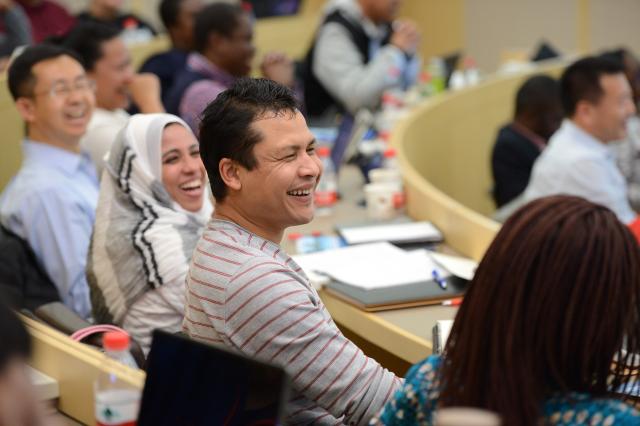


As part of its drive towards scholastic excellence and in pursuit of its self-sacrificing objective as one of China's premier universities, the Peking University Public Policy Forum International draws from the spring of knowledge from experts in various fields and institutions around the world. The significance of the Public Policy International Forum is to provide diverse and in-depth understanding to students at the National School of Development (NSD) and the Institute of South-South Cooperation and Development (ISSCAD). As a welcome back to the rigorous but yet rewarding academic life, NSD and ISSCAD organized the first spring semester international forum on 1 March 2018. The guest speakers were executives from the European Bank for Reconstruction and Development (EBRD) represented by Mr. Ralph De Haas, Director of Research and Mr. Gavin Anderson, Executive Counselor.
In his welcome and introductory remarks, the Academic Dean of the ISSCAD, Professor FU Jun notified students of ISSCAD and other schools and professors in attendance that in order to "understand better, we should have international outlook and for people to understand China better, these international experts should come to China to learn why these countries are stuck in the middle-income trap". It was Professor FU Jun's hope that the discourse will be very educational and interactive for all students including the faculty as well.
The model of the middle-income trap can be traced to the onset of the Global Financial Crisis (2008). Prior to that time, the European Regions consistently outperformed by attaining on average a 15% growth rate (1998-2008). But immediately following the year (2009), the region began to experience a nose-dive (9%) in growth. This trend in economic growth followed the path of divergence instead of convergence. Ironically, throughout this same period, the People's Republic of China continued to show vibrant economic performance due to its ability to adapt and change over time so as to continuously climb the value-added ladder of domestic and international trade in goods and services.
While other countries in Sub-Sahara Africa, Latin America and several Asian countries are moving slow on the Total Factor Productivity trajectory as compared to the European Regions, China, on the other hand, has been consistently high and impressive in terms of TFP. The architect of the New Structural Economics, a former Senior Economist at the World Bank and Dean of the National School of Development at Peking University, Professor Justin Lin observed in a C-Span interview that one reason countries are weighed down in the middle-income trap is because these countries were incapable of developing a very dynamic structural transformation in order to constantly advance their labor productivity and income labor faster than the high-income countries. He blamed the failure of these countries to move out of the middle-income trap on their governments' inability to play the necessary facilitating and match up role to overcome the externalities or coordinating issues that are instinctive of the structural transformation process.
How does the drive to improve TFP affect the need for new markets since in fact most if not all of the countries would have had considerable improvements in their mode of production? In response to the linkages between Total Factor Productivity (a measure of the efficiency of all inputs to a production process which is usually derived from technological innovations or improvements in the mode of production and markets), Mr. Haas noted that in countries with large domestic markets, such as China, firms will have large enough local markets in order to make innovation pay off. So we would expect firms to improve their inventions and production processes - and hence increase TFP- because they know they can earn back the fixed cost of innovation by selling many units across the country. But in smaller countries, the local market may be too diminutive to make TFP improvements pay off. Firms will then only innovate if they can reap economies of scale by also exporting part of their production to foreign markets which may not necessarily yield the needed increase in growth.
One of the country's comparative advantage which is giving rise to China's TFP is the number of patents that it has been able to register within the space of a decade which has surpassed the EBRD region. In 2015 alone, the Chinese Intellectual Property Office received pretty close to one million patent applications with most of the patents relating to the telecoms, computing, semiconductors and medical technology.
The more patents, by and large, the more technological advancement the country becomes and this is the dilemma that some Central Asia, Eastern European and Latin America are faced with today. Today, there are few countries that are adapting to China's rise in technological innovation. The use of OFO in other European countries is just one example. The use of scanning of the barcode as the medium of the transaction is another farsighted advancement on the part of China. From the lower level of the economy including the payment for transportation or the purchase of goods at the local deli or grocery stores, the use of money is relatively invisible as almost every transaction is conducted electronically.
Can we conclude that the slowdown in growth after the Global Financial Crisis of 2008 has kept the EBRD member states in a Middle-Income Trap? For Mr. Haas, he believes that the results of this year’s Transition Report show that various countries in the EBRD region are experiencing middle-income “trouble”. They are finding it difficult to move from growth based on the technology adoption of existing (foreign) technologies to growth based on new inventions that push the global technological frontier.
In terms of cross-country comparison, Mr. Haas pointed out that industries that are far from the United States' benchmark (James Williamson's Washington Consensus) are growing fast as compared to countries that have adopted the US benchmark. If you are far away from the US you are more productive than the US and the closer you are, your productivity goes down. He noted that countries that are interested in pushing the growth of their firms, must expose them to the rigor of international trade because firms that are more productive are the ones absorbing more labor.
While the EU is trying to get out of the MIT by improving its innovation through technological advancement, there is still another trap: The empirically predictable and yet avoidable "Thucydides Trap". Allison Graham, a "China Watcher" in the state of his art masterpiece " Destined for War" noted with historical evidence the rivalry that has developed between a "ruling power and a rising power" using Sparta and Athens as historical examples and conventionally, the first and second largest economies as contemporary examples.
While the "the Middle Income Trap" quandary is to European nations especially Eastern and Central Europe, and the Thucydides Trap is to the United States and China, yet still, there is another trap. Situated in developing countries, especially in Africa, the "poverty trap" introduced by development economists such as Jeffrey Sachs Abhijit V. Banerjee, Esther Duflo, Paul Collier and many others tell the tale of how political, military and institutional instabilities as well as the misuse of natural resources can keep a nation in a vicious cycle of poverty for generations.
Escaping the middle-income trap will first and foremost require high investment in technological innovation in terms of total factor productivity. Escaping the poverty trap, on the other hand, will also require the use of a country's natural resources and endowment with a focus on labor-intensive production through light manufacturing in the first instance. However, escaping both traps will require the role of the state in facilitating and coordinating the transformational process of economic growth, a new thinking embedded in a new structural economic.
Editor: Olivia LOU
